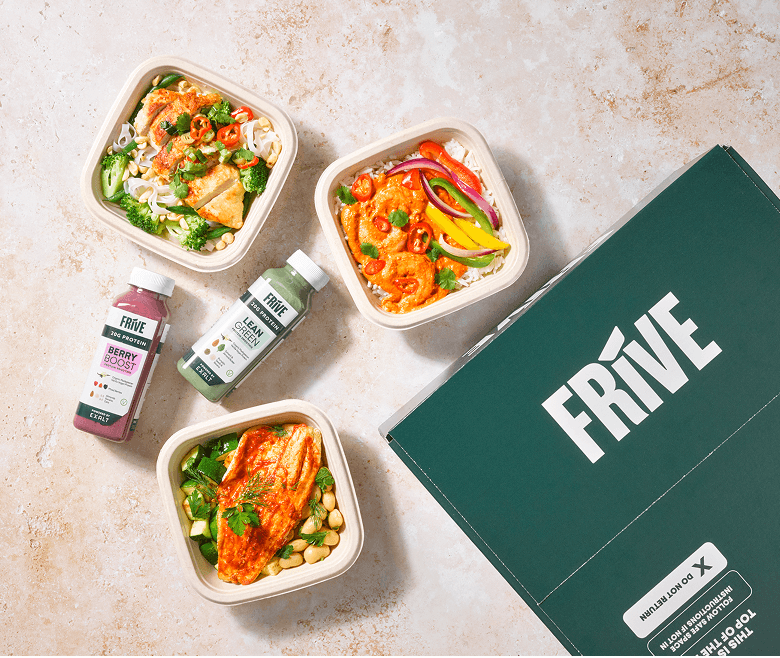More people in the UK are using apps and tools to track their nutrition, especially macronutrients such as protein, carbohydrates and fats. The UK and Germany diet and nutrition apps market is set to grow at about 18.7% annually through 2030, showing that monitoring macros is moving from gym culture into everyday habits.
Studies also show balanced macronutrient intake is linked to better energy levels, stable mood and healthier metabolic markers. Another UK-based study found that replacing saturated fats and sugar intake improves blood lipid profiles, a strong signal that macro ratios matter.
In this guide, you’ll learn exactly what a macro-balanced meal plan is and how you can build one that works for your goals. We cover typical macro ratios, sample meals (including Frive options) and tips to keep things simple and sustainable.
At a glance: Key points on macro-balanced meal plans
- - A macro-balanced meal plan includes all three macronutrients (protein, carbohydrates and fats) in the right proportions for steady fuel.
- - Typical ratios like 40/30/30 can be adjusted for different goals such as weight loss, muscle gain or general energy.
- - Balanced macros support better mood, weight management, digestion, gut health, performance and recovery compared to restrictive diets.
What is a macro-balanced meal plan?
A macro-balanced meal plan makes sure your diet includes the three macronutrients your body needs most: carbohydrates for energy, protein for muscle repair and fats for hormone health and vitamin absorption. Instead of cutting any group out, macro-balanced meals help you get the right proportions on your plate.
A common starting point is around 40% carbs, 30% protein and 30% fats, though the exact split can shift depending on your goals. Endurance training may call for more carbs, while building muscle often requires more protein.
The benefit of this approach is balance. Unlike restrictive diets that eliminate carbs or fats completely, a macro-balanced plan offers flexibility and variety. Nothing is off-limits as long as it fits your daily macros, which makes it easier to stick with it in the long term.
Benefits of a macro-balanced approach
Balanced macro meals do more than simply improve your diet. When you get carbs, protein and fats in the right proportions, you support your body in ways that go beyond calories. For many, this balance also improves mental health and mood regulation.
Here are some of the top benefits and the science behind them.
Better energy and mood stability
Eating a balanced mix of macronutrients helps your blood sugar stay steadier throughout the day. Studies link macronutrient balance with a lower risk of mood swings and depression. For example, a recent paper found that higher intakes of protein and carbs are associated with better mood and lower depressive symptoms in adults.
Easier weight management
Meals with adequate protein help you feel fuller for longer and reduce cravings. A review in the British Journal of Nutrition showed that diets with at least 25-30% of calories from protein support both weight loss and maintenance by increasing satiety and preserving muscle mass.
Improved digestion and satiety
Protein-rich foods, combined with fibre from carbohydrates and healthy fats, slow digestion slightly to help you feel satisfied longer. Research shows that plant proteins like pea and casein improve fullness more than some other protein types, helping reduce overall food intake.
Better performance and recovery
For those doing physical work or workouts, macro balance matters beyond rest days. After exercise, consuming the right combination of protein and carbs supports muscle repair, replenishes energy stores and improves recovery.
Avoiding nutrient gaps from restrictive diets
Cutting out major food groups can mean missing out on essential vitamins and minerals. A macro-balanced approach keeps all three macronutrients on your plate, giving space for variety, like whole grains, vegetables, lean proteins and healthy fats, reducing the risk of deficiencies. It’s also far easier to stick to long-term than restrictive diets.

Frive’s Taiwanese Chilli Chicken
What does a macro-balanced meal look like?
A balanced macro meal plan isn’t as complicated as it may sound. You don’t need to count every gram, but having a rough sense of balance helps. Here are a few examples of what that could look like in real life.
A typical lunch: high-protein bowl
Protein-rich lunches help steady energy through the afternoon. A good example is Satay Chicken with fried rice and peppers, which contains 58g of protein. Chicken provides lean protein, rice gives carbs and the peanut sauce adds healthy fats. Together, it’s a filling but balanced option that supports focus well past lunch hour.
A plant-based dinner with balanced macros
Plant-based meals can be macro-balanced too, provided they include a good protein source. Satay Tofu with fried rice and peppers delivers 30g of protein alongside carbs from rice and nutrient-dense fats from the creamy coconut-peanut sauce. Fibre from the vegetables rounds it out, making it a satisfying dinner without relying on meat or fish.
Low-carb option for weight loss
For people focusing on weight loss, reducing carbs slightly can make meals feel lighter while still giving enough energy. Red Thai Prawns with cabbage rice and vegetables is a great low-carb swap that doesn’t compromise on flavour. It replaces traditional rice with cabbage rice, keeps 33g of protein from prawns and adds healthy fats from the Thai sauce.
Energy-boosting macro meal for busy days
When you know the day ahead is full-on, meals with balanced macronutrients give the steady energy you need. Thai Ginger Bass with spring onion rice & mango Thai basil salsa does exactly that, combining 33g of protein from fish, carbs from rice and healthy fats from the dressing. The mango salsa adds freshness and micronutrients, making it a smart pick when you want sustained energy.
Macro-balanced meals vs fad diets
Fad diets often promise quick wins, but they tend to fall short when it comes to nutritional quality or long-term results. Macro-balanced eating is more flexible, more evidence-based and easier to maintain. Here’s how they compare:
| Approach | Method | Short-term effects | Drawbacks |
|---|---|---|---|
| Macro-balanced meals |
Include carbohydrates, proteins and healthy fats in each meal. Use moderate ratios like 40/30/30 or similar, depending on your goal. |
Steadier energy, better mood and more satisfaction after eating. |
Few restrictions means it’s easier to stick with. Supports nutrient diversity. Less likely to lead to burnout or nutritional gaps. |
| Keto / very low-carb diets |
Heavy restriction of carbs to fewer than
20-50 grams per day. Focus on high-fat foods like meat, fish, eggs and nuts. |
Rapid weight loss. Can sometimes improve blood glucose control in the first few weeks. |
Hard to sustain. A high risk of missing fibre and some vitamins, minerals and macronutrients. Potentially unwanted effects for heart health if fats are poor quality. Limited variety of food choices. Harvard Health notes keto is effective short-term but often declines in adherence and can result in potential health issues long-term. |
| Juice cleanses / juice-only diets |
Consume only juices or fruit/veg extracts. Juice cleanses typically only last for a few days. |
It can give you a quick sense of lightness. Higher intake of vitamins. Some weight loss (mostly water or glycogen loss). |
Low in protein and fats. Consists of little to no fibre. Studies show they can disrupt gut bacteria, resulting in inflammation, cause blood sugar spikes and are unsustainable in the long term. |
| Meal skipping / extreme calorie restriction | You skip entire meals or severely cut calories to lose weight. |
Initial weight loss. Often easier to track for some. |
Is unsustainable and associated with
impaired immune function. Can lead to energy crashes, poor mood, muscle loss and worse metabolic health. |
Why macro-balanced is more sustainable
- - Macro-balanced diets allow you to eat a wider variety of foods, which supports adequate nutrient intake and keeps meals interesting.
- - You are less likely to feel deprived or restricted, which usually means you’re more likely to stick to it.
- - While diets like keto or juice cleanses may deliver quick results, many people regain weight or abandon them because they’re too rigid or have negative health trade-offs.
Personalising your macro ratios: what macro ratio is right for you?
Macro needs are not the same for everyone, and the right ratio depends on your lifestyle and how active you are. While general guidelines suggest balanced splits such as 40% carbs, 30% protein and 30% fat, small adjustments can make a big difference, and tools like the StrongrFastr macro meal plan builder can help you fine-tune your own needs. Here are some common health goals to give you an idea:
- - Weight loss: A slightly higher protein intake helps protect muscle while keeping you full. A common ratio is around 40% protein, 30% carbs and 30% fats. If that’s your goal, a weight-loss-tailored meal plan can help you stay on track.
- - Muscle gain: To support training and recovery, carbs play a bigger role. Many people aim for something like 50% carbs, 25% protein and 25% fats.
- - Steady energy and health: For balanced focus and wellbeing, a classic 40/30/30 split works well for most people.
Frive makes it easier to match meals to your goals. All of our meals are portioned and nutritionist-approved, so you can stay consistent with your chosen macro balance without having to work out ratios or calculate numbers every time you sit down to eat.

Frives Lemongrass & Coconut Tofu Curry
The best foods to match your macros
Balancing macros starts with picking foods that naturally lean towards protein, fat, or carbohydrates. Choosing the right sources helps you meet your targets and keeps meals satisfying and nutrient-dense.
High-protein
- - Lean meats such as chicken, turkey and white fish provide plenty of protein without too much added fat.
- - Eggs are a versatile option, with around 6g of high-quality protein each, supporting muscle repair and keeping you fuller for longer.
- - Dairy foods like Greek yoghurt, milk and cottage cheese contain a good balance of protein and calcium, which supports bone health.
- - For plant-based eaters, beans, peas, lentils, tofu and tempeh supply protein along with fibre and a wide mix of vitamins and minerals.
High-fat
- - Avocados, olive oil, nuts (like almonds and walnuts) and seeds (such as chia or flax) are rich in essential fatty acids that support hormone balance and healthy cells.
- - Fatty fish, including salmon, sardines and mackerel, add both protein and omega-3s, linked to better heart health and brain function.
- - Natural nut butters and moderate portions of full-fat dairy can add flavour and balance meals, offering flavour, satiety and slow-release energy.
High-carb
- - Wholegrains such as oats, quinoa, brown rice and wholewheat pasta deliver slow-release energy, fibre and B-vitamins, making them ideal for sustained focus.
- - Starchy vegetables like sweet potatoes, parsnips and squash are naturally nutrient-dense while providing complex carbs that fuel activity.
- - Fruits and non-starchy vegetables boost your intake of vitamins, minerals and antioxidants, while legumes like chickpeas and beans give you both carbs and a bonus dose of protein.
Tips for staying consistent with your macros
Hitting your macro goals once is easy, but keeping it up day after day is where real progress happens. A few simple habits can make the difference between falling off track and finding a rhythm that lasts.
- - Plan ahead: Even a quick outline of your meals for the week helps you stay balanced and removes guesswork when you’re hungry.
- - Keep variety on your plate: Rotating proteins, grains and vegetables stops meals from feeling repetitive and ensures a wider spread of nutrients.
- - Prep smarter, not harder: Batch-cook one or two staples like chicken, rice or roasted vegetables, then mix and match through the week.
- - Use a tracking tool: Apps like MyFitnessPal or Cronometer can help you log meals and spot where adjustments are needed, especially when you’re just starting out.
- - Lean on support: A meal prep delivery service like Frive takes the pressure off by delivering macro-balanced meals designed by chefs and nutritionists. That way, you know every plate hits the right balance without needing to calculate or measure it for yourself.
- - Stay flexible: Perfection isn’t the goal. If you’re close to your targets most of the time, you’ll still get the benefits without feeling restricted.
Make macro-balanced eating simple with Frive
Getting your macros right can feel complicated, but Frive takes the guesswork out. Each meal is crafted by chefs and approved by nutritionists with protein, carbs and healthy fats already portioned in the right balance. Clear nutritional information lets you see exactly what you are eating without the need to calculate or track.
Whether you want high protein dishes, low-carb recipes or plant-based options, Frive offers a rotating menu that keeps meals varied while staying on target. Customers love how easy it is to stay consistent: “Fantastic meals that fit my calorie and macro needs” and “Great idea for quick macro-friendly meals.”
A macro-balanced approach fuels better mood, steady energy and healthier weight management without the restrictions of fad diets. With Frive, you can build a lasting routine and enjoy balanced eating every day, no planning, no measuring, just fresh meals ready in minutes.
Explore Frive today and start your journey to stress-free macro-balanced eating.
FAQs
What is a macro-balanced meal plan?
A macro-balanced meal plan includes all three macronutrients: protein, carbohydrates and healthy fats in proportions that support steady energy, satiety and overall health. A common starting ratio is 40 percent carbs, 30 percent protein and 30 percent fats, but this can be adjusted to your personal goals.
How do I figure out the right macro ratio for my body?
Start with a general 40/30/30 split of carbs, protein and fats and adjust based on your activity level and goals. Higher protein ratios such as 40 percent protein can support weight loss, while endurance training may call for more carbohydrates. Online macro calculators and tracking apps can help you fine tune the numbers.
What foods are best for a macro-balanced diet?
Build meals around lean proteins such as chicken, fish, tofu and beans, slow-release carbs like whole grains, sweet potatoes and fruit, and healthy fats from avocado, olive oil and nuts. Mixing plant-based and animal sources provides a wider range of nutrients and keeps meals satisfying.
Is a macro-balanced meal plan good for weight loss?
Yes. Adequate protein and fibre help you stay fuller for longer, making it easier to maintain a calorie deficit without feeling deprived. Balanced macros also stabilise blood sugar which can reduce cravings compared to restrictive diets.
Do I need to count every gram of macros to see results?
Not necessarily. Tracking can help at first, but many people move to a plate method once they understand portions. Aim for roughly half vegetables, one quarter lean protein and one quarter complex carbs with a small serving of healthy fat.
How can I eat macro-balanced meals when I am busy?
Batch cook proteins and grains, plan a weekly menu, or use a meal delivery service like Frive to save time and remove guesswork. Ready-to-heat macro-balanced meals make it easier to stay on track even on hectic days.



